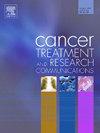一线durvalumab联合铂依托泊苷治疗日本广泛期小细胞肺癌患者
IF 2.4
Q3 Medicine
引用次数: 0
摘要
背景:基于铂的化疗联合免疫检查点抑制剂治疗最近被用于治疗广泛期小细胞肺癌(ES-SCLC)。在III期CASPIAN研究中,一线依托泊苷(etoposide)联合顺铂/卡铂(EP) + durvalumab可显著提高ES-SCLC患者的生存率。然而,它包括很少的日本患者,强调需要评估这种治疗的有效性和安全性,特别是在日本人群中。方法回顾性调查2020年8月1日至2023年12月31日期间日本8家医院的treatment-naïve ES-SCLC患者。他们每3周接受EP + durvalumab(4个周期),随后每4周接受维持durvalumab,直到疾病进展。主要终点是安全性,次要终点是总生存期、无进展生存期、客观缓解率和疾病控制率。结果纳入69例患者,年龄48 ~ 91岁,中位年龄72岁。大多数患者的东部肿瘤合作组绩效评分为0或1。72.5%的患者发生≥3级不良事件,21.7%的患者发生免疫相关不良事件。中位总生存期为15.0个月(95%可信区间:11.6-20.0),而中位无进展生存期为5.0个月(95%可信区间:4.3-5.8)。客观有效率为75.4%,疾病控制率为92.8%。结论:一线EP + durvalumab对日本ES-SCLC患者有效且耐受性良好,与全球研究结果一致。该方案应被视为日本ES-SCLC患者的标准治疗方案。本文章由计算机程序翻译,如有差异,请以英文原文为准。
First-line durvalumab plus platinum–etoposide in Japanese patients with extensive-stage small-cell lung cancer
Background
Platinum-based chemotherapy combined with immune checkpoint inhibitor therapy has recently been introduced for treating extensive-stage small-cell lung cancer (ES-SCLC). In the Phase III CASPIAN study, first-line etoposide (Etoposide) with cisplatin / carboplatin (EP) plus durvalumab significantly improved survival in patients with ES-SCLC. However, it included few Japanese patients, underscoring the need for evaluating the efficacy and safety of this treatment specifically in the Japanese population.
Methods
Patients with treatment-naïve ES-SCLC were retrospectively investigated at eight hospitals in Japan, between August 1, 2020 and December 31, 2023. They received EP plus durvalumab (four cycles) every 3 weeks, followed by maintenance durvalumab every 4 weeks until disease progression. The primary endpoint was safety, while the secondary endpoints were overall survival, progression-free survival, objective response rate, and disease control rate.
Results
Sixty-nine patients aged 48–91 years (median: 72 years) were included. Most had an Eastern Cooperative Oncology Group performance status of 0 or 1. Grade ≥3 adverse events occurred in 72.5 % of patients and immune-related adverse events in 21.7 %. The median overall survival was 15.0 months (95 % confidence interval: 11.6–20.0), while the median progression-free survival was 5.0 months (95 % confidence interval: 4.3–5.8). Objective response and disease control rates were 75.4 % and 92.8 %, respectively.
Conclusion
First-line EP plus durvalumab was effective and well tolerated in Japanese patients with ES-SCLC in a real-world setting aligning with findings of global studies. This regimen should be considered the standard of care for Japanese patients with ES-SCLC.
求助全文
通过发布文献求助,成功后即可免费获取论文全文。
去求助
来源期刊

Cancer treatment and research communications
Medicine-Oncology
CiteScore
4.30
自引率
0.00%
发文量
148
审稿时长
56 days
期刊介绍:
Cancer Treatment and Research Communications is an international peer-reviewed publication dedicated to providing comprehensive basic, translational, and clinical oncology research. The journal is devoted to articles on detection, diagnosis, prevention, policy, and treatment of cancer and provides a global forum for the nurturing and development of future generations of oncology scientists. Cancer Treatment and Research Communications publishes comprehensive reviews and original studies describing various aspects of basic through clinical research of all tumor types. The journal also accepts clinical studies in oncology, with an emphasis on prospective early phase clinical trials. Specific areas of interest include basic, translational, and clinical research and mechanistic approaches; cancer biology; molecular carcinogenesis; genetics and genomics; stem cell and developmental biology; immunology; molecular and cellular oncology; systems biology; drug sensitivity and resistance; gene and antisense therapy; pathology, markers, and prognostic indicators; chemoprevention strategies; multimodality therapy; cancer policy; and integration of various approaches. Our mission is to be the premier source of relevant information through promoting excellence in research and facilitating the timely translation of that science to health care and clinical practice.
 求助内容:
求助内容: 应助结果提醒方式:
应助结果提醒方式:


